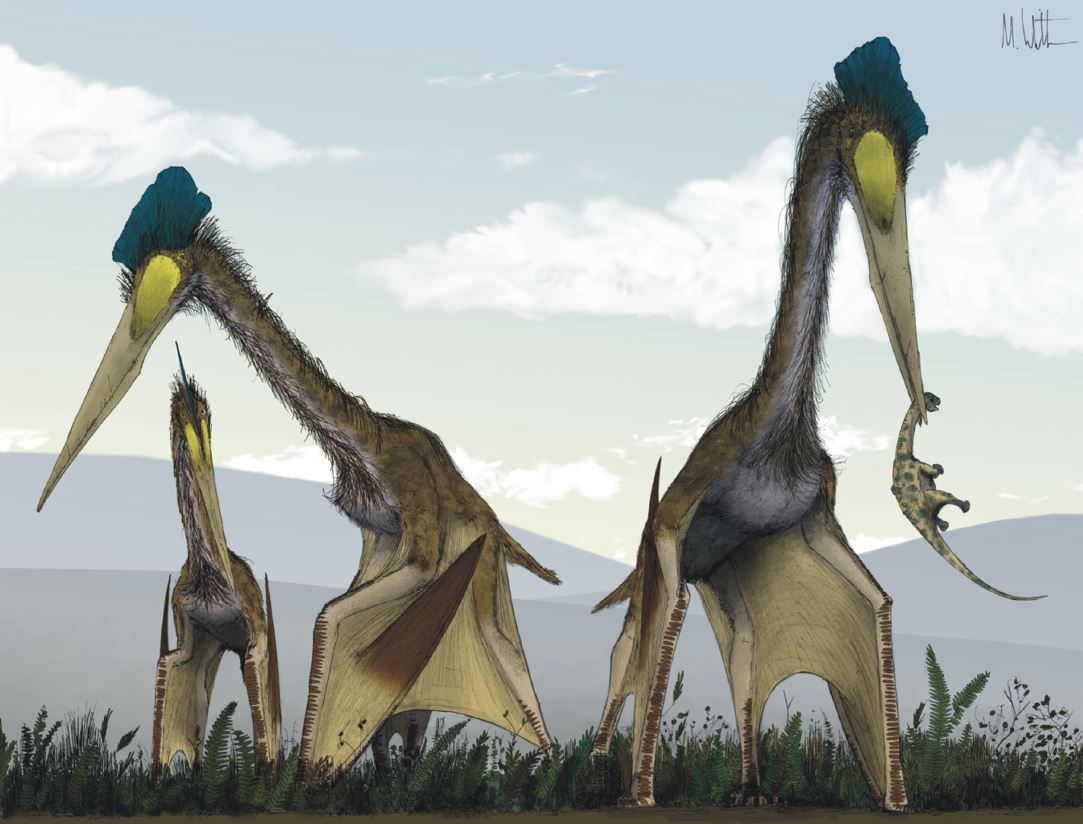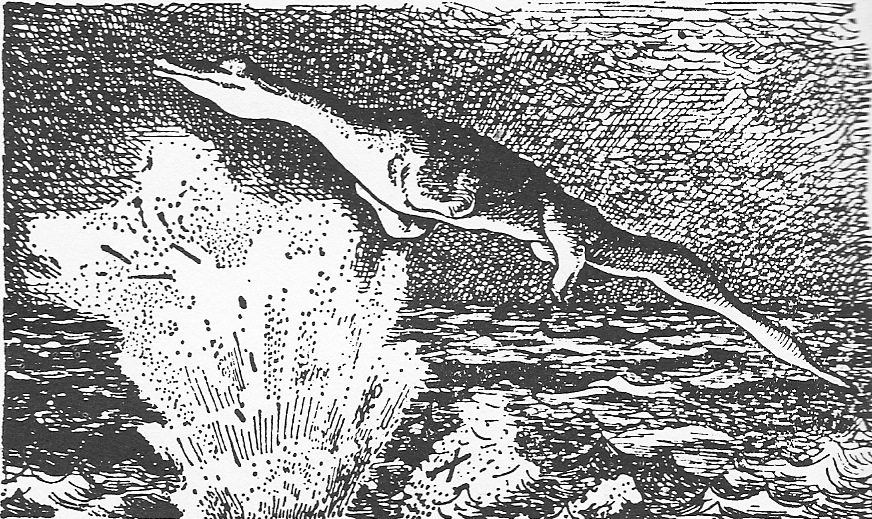
Ok, here we go on a thread relating to the science and decisions behind ep 3 (FRESHWATER) of #PrehistoricPlanet , our new @AppleTVPlus @bbcstudios series devoted to Late #Cretaceous life. Here we go... #dinosaurs #pterosaurs #plesiosaurs #frogs 



Freshwater kicks off in north-east Asia (a location consistent with the geology, climate and animals we show) with a spectacular waterfall connected to canyons. Juvenile #pterosaurs - they're young #azhdarchids - have gathered here to roost... #PrehistoricPlanet 

We know essentially nothing of the roosting or resting habits of #azhdarchids but see it as likely that they would have gathered in numbers (fossil evidence does show that they were social) in places that predators couldn't easily get to. Hat-tip to discussion with @MarkWitton ..
We don't pin down the taxonomic identity of these #azhdarchids but know from fossils that they occurred near-worldwide at this time, definitely in our area of interest. Look for quad launch, narrow gait and so much else we know was present in these animals [pics by @MarkWitton].. 



The stars of the sequence are the velociraptorines. Yes, they might not specifically be #Velociraptor itself but we couldn't refer to them as 'indeterminate velociraptorines' :) THIS is the modern, scientifically accurate look of these amazing animals... #PrehistoricPlanet 



Yes, as fully feathered as modern birds, equipped with wing-like forelimbs & broad tails. Note how they boost their jumps and use the feathered surface to change direction, control descent and even as protection from surfaces. Issues relevant to feather presence and evolution!
So much more could be said.. group hunting - perhaps involving related individuals - is supported for these animals (not 'pack hunting'), as is opportunistic predation mostly involving animals smaller than themselves... #PrehistoricPlanet
Incidentally, our natural history savvy group at @bbcstudios Natural History Unit did NOT use the term 'raptor' for these animals. Why? Because it's widely used among ppl who study living animals for another group: hawks, eagles, vultures etc ... and thus results in confusion... 

We move on to the #Trex courtship scene. The focus here is not predation (we see our male #tyrannosaurusrex eating a deceased #Triceratops) but some of the other stuff that this animal MUST have engaged in...
Our individual is an old male (#Trex lived to around 30), his scars, injuries and missing tail tip are all inspired by real injuries seen on T. rex fossils (yes, there is one with a partially missing tail). We see him drink using 'scoop drinking' or gravity-assisted drinking...
How did we determine the courtship postures and vocalisations that might exist in T. rex? We looked at postures and calls made by living archosaurs that 'bracket' T. rex and found commonalities. Appeasement/conciliation in living archosaurs involves head lifting, throat display.. 

... and - while aggressive broadcast bellows _can_ be issued with an open mouth - contact calls and advertisement calls are often 'close-mouthed' sounds that emanate widely from chests and necks... #PrehistoricPlanet
Evidence from tyrannosaur facial bones shows that they had high nervous sensitivity across the jaws and face, and that ritualised facial contact (involving rubbing, nuzzling and biting) was something they did. A courting pair very likely engaged in facial contact, as we show... 

Everything about the mating sequence was informed by phylogenetic bracketing: believe it or not, lots of work has been done on the mating postures and habits of non-bird dinosaurs, much of it informed by work on living archosaurs (crocodylians and birds) [pics from Isles 2009] .. 



This explains why our mating tyrannosaurs are low to the ground: a famous museum mount in Spain which shows mating occurring in a standing-tall position is not likely to be correct... 

We move on to Asian wetlands where we meet the remarkable #Deinocheirus, a giant member of the ostrich dinosaur or onithomimosaur group. It looks incredible! #PrehistoricPlanet #dinosaurs 



#Deinocheirus was named in 1970 and was long known only from its 2.4m arms, shoulder girdles and some ribs [photo shows Zofia Kielan-Jaworowska with the fossil] BUT much of the rest of the animal was found in the 2010s... I was lucky enough to see this before it was published... 

To learn more about #Deinocheirus and how we came to understand and reconstruct it, I recommend this thread by my excellent colleague @TomHoltzPaleo ....
https://twitter.com/TomHoltzPaleo/status/1529447039003766785#PrehistoricPlanet #dinosaurus
We opted to make #Deinocheirus shaggy-coated, something that's the source of discussion among experts. We know that smaller #ornithomimosaurs were like this but uncertainty surrounds the giant ones... [drawings by me] #dinosaurs 

When we started building our #Deinocheirus model, our understanding of its environment indicated cool or even cold environments, plus there are reasons for thinking that dinosaurs were/are better at temperate control than big mammals. We await more data and more study :)
I'm now way overtime! We move to southern Africa where we see the giant #azhdarchid #Quetzalcoatlus build a nest. Quetz is N American but experts have argued that these giant, superb soarers may likely have been 'continent hoppers', literally with trans-oceanic distributions ... 

As she lands, she halts flight with 2-3 powerful downbeats before dropping to the ground, before folding her wings and adopting a tall, narrow quadrupedal posture. The idea that #azhdarchids could do this was put forward by Witton & Naish in 2008 ... journals.plos.org/plosone/articl…
Her nesting behaviour is key to the sequence. A little is known about #pterosaur eggs and nesting, but not much. Their eggs were soft-shelled and hence buried in damp substrates (soil, sand or vegetation), and those of #azhdarchid would have been big: we estimate about 1kg each!
We also know from fossils that #pterosaurs could produce 2 eggs at once (one from each ovary). Clutch size might have been tiny (2) or large (c 12): we opted for larger since the total clutch mass of this size appeared right for an animal this large (Quetz was around 220 kg)...
Lots of science behind launch dynamics we show (#pterosaurs used 'quad launch', pushing off with the massive forelimbs) and also the logic behind their sounds (deep, airy sounds and booms - no shrieks or screams!) and even combat style... #PrehistoricPlanet
The episode moves to Madagascar (though this isn't stated in the narration) where we focus on the noasaurid theropod Masiakasaurus (pronounced 'ma-sheek-ah-saw-rus')... #dinosaurs #PrehistoricPlanet 

Masiakasaurus is famous for its protruding lower jaw teeth, probably used in grabbing small animal prey of diverse sorts [photo by Evoluitonnumber9, CC BY-SA 4.0]. Conventional reconstructions show these teeth radiating outwards and always obvious but -- 

.... with the jaw properly aligned and soft tissue added they just would not have been obvious when the jaws were closed, sorry! Crabs are just one of among many animals it might have preyed on. We specifically show portunoid crabs, a group widespread in Late Cretaceous times...
SUDDENTLY #BEELZEBUFO! Yes, the big, broad-mouthed #frog Beelzebufo, named in 2008, may well have been a danger to small dinosaurs. Its superficial similarity to living pac-man frogs is obvious, see also the skin-covered armour plates on its surface and pointy upper jaw teeth... 



When first described, #Beelzebufo was posited as a giant about 43 cm long (excluding legs); it's since been downsized to about 23 cm, but a rough maximum of about 30 cm (the width would have been similar) is plausible. Pics from Evans et al. 2008, 2014... #PrehistoricPlanet 

There's a tendency to make #Beelzebufo look like a modern S American horned toad (the terms 'frog' and 'toad' are essentially interchangeable according to superficial appearance) but this idea is not good and we avoided it. Here are my drawings of both: pretty different! 



Time to wrap up!! The ep finishes by hopping to South America (though this isn't stated) where we see giant #azhdarchids AGAIN (remember, they're global!), plus titanosaurian #sauropods and elasmosaurian #plesiosaurs in freshwater and an estuary...
Elasmosaurs were mostly marine but the fossils of small and mid-sized individuals (juveniles of marine forms, or specialised freshwater/estuarine forms -- probably both!) are known from rivers in many locations...
.... they seem to have exploited these environments just as many mostly marine animal groups do today. And thus ends ep 3 of #PrehistoricPlanet , thanks for reading! Ep 4 ICE WORLDS next. @AppleTVPlus @bbcstudios 



Favourite typo: SUDDENTLY :)
I should finish this #PrehistoricPlanet thread by emphasising was a >massive team collaboration< this was: over 1500 people - artists, designers, writers, directors, producers and many more - contributing from @bbcstudios #NaturalHistoryUnit @MPCVFX @JellyfishPics @AppleTVPlus :)
• • •
Missing some Tweet in this thread? You can try to
force a refresh




















